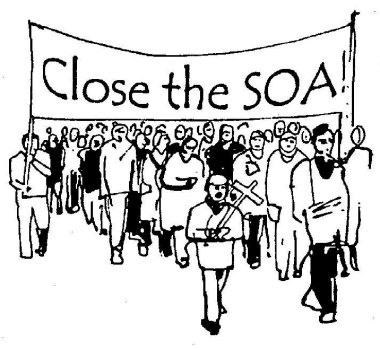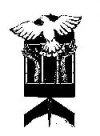
 Compiled from accounts by Linda Panetta and others
Compiled from accounts by Linda Panetta and others 
 Compiled from accounts by Linda Panetta and others
Compiled from accounts by Linda Panetta and others
The prelude to massive protest symbolized the stark reality that would again bring more than 10,000 people to the School of the Americas (SOA) at Fort Benning, Georgia in late November.
Early on the morning of November 14, Josh Raisler Cohn hung a banner from a roadway overpass inside the sprawling base, proclaiming "SOA Kills in Latin America." He then carefully suspended his own body nearby, a symbolic hanging. Cohn was arrested and released with a five year ban from the base.
Five days later, despite cold and relentless rain, 3,400 people - families, clergy , students, veterans, grandmothers and grandfathers - crossed the line into Fort Benning to demand the closure of the school notorious for teaching the ways of terror and repression to commanders and soldiers from Central and South America.
The traditional funeral procession onto the base began with protesters in death masks and black funeral shrouds who staged a die-in in the front of the line. As the procession advanced, names of the scores of Latin Americans killed by SOA graduates were read from the stage. After each name thousands responded "Presente!" - they are here with us.
When the procession was stopped by the military police some of the protesters voluntarily walked onto the waiting busses; others refused to move and were carried on board limp. Still others decided to walk off the base and rejoin the vigil at the gates.
As the last participants in this traditional funeral procession continued down the road to the SOA, the second wave of affinity group actions began. From the stage, a narration of Colombia's El Salado massacre was recited, while in the background the military-like beat of a single drum was heard. Thirty-two people, ranging in age from 20 to 70, made their way to the outgoing road of the base. All but six of the protesters played the part of peasants who, when they reached the road, held hands and danced in a circle. Three protesters dressed as paramilitaries came forward and began to massacre the peasants - swinging their cardboard weapons like machetes and pouring red paint on them to symbolize the real blood shed nine months earlier to the day. All the while, a protester dressed as the Colombian military stood by and allowed the massacre to continue. Before the military police came forward to make arrests, an American flag was placed over the victims' bodies.
Shortly after the traditional funeral procession began at the main gate, two "military" personnel with cardboard guns led seven peasants, who were blindfolded, onto the base at the Custer Road entrance. When they were met by the military police, the activists playing military personnel then ordered the peasants to kneel across the road, blocking traffic, and "shot" each one in the head.
Statements were made about which different country in Latin America each peasant was from, and why the army was killing them. Fake blood was then poured onto the victims. As the military began to arrest the activists a group of four other people appeared, being led by MPs. They had entered via Fort Benning Road, two miles south of the main gate, and were marching down the road to the SOA building planting crosses along their way. They were all taken for processing.
The Second Wave of crossers came just following the reenactment of the
Colombia massacre. These protesters were committed to "keep on walking"
to the SOA. They entered on the ingoing road, moved to the left across
the grassy area and then moved forward onto the exit road. When the "walkers"
were met by military police and asked to stop, the protesters walked past
the officers and continued walking forward. They were taken onto a bus
and processed. 
The Third Wave of crossers entered onto the base at the Main Gate in a parade of puppets and songs. Three local youth led the procession carrying a bloody rendition of the SOA building. Puppets of soldiers, helicopters, women in traditional Guatemalan dress as well as a 12' tall yellow head and fist symbolizing the people's revolution for global justice followed them. Cheering and singing, this group of about 80 entered on the ingoing road and later crossed the median to the exit road. The puppet cluster fanned out, moving into the woods and onto the grass, using spoons to plant corn, sowing the seeds of life and change on the grounds of Ft. Benning. Many of the Third Wave were loaded onto busses and taken away for processing. That day in Mexico, people in Chiapas also crossed onto army bases and planted corn. North and South, the people in opposition to the SOA and the violence of globalization acted in solidarity.
Later, as the three youth who led the puppet procession separated from the crowd to walk home, they were arrested by military police, handcuffed face down, and taken to a separate processing center before being released miles from home. SOA-Watch organizers, following up on eye-witness accounts of this harassment, contacted the public affairs office at Fort Benning. After providing an generally unsatisfactory account of official actions, the base spokesman told organizer Jeff Winder, "The things people are putting out there that our MPs did are just outrageous. Frankly, it's like the things SOA Watch puts on the webpage. How anyone can believe that people are taught to torture and kill here is beyond me."
Winder concluded, "It seems like the usual line of defense, to attack the credibility of those who make the allegations. Clearly, these three youth were singled out and treated differently from the vast majority of the protesters. Was it to send a warning to other local residents who might join in the resistance to SOA violence? Was it easier for the MPs to single these three out for harsher treatment because they are young and African-American? Nonviolent action often brings to light the structural violence in a way that hits closer to home. A system that supports violence abetted by the SOA, directed against those who are most vulnerable in Latin America is obviously capable of singling out the most vulnerable protesters here for harsher treatment.
"SOA Watch thanks these brave youth for joining in the protest against the School of the Americas. The risk for them was, and is, much greater than it is for most of us."
In total, approximately 2,100 people were processed, receiving a five year ban and bar from the base. At least 65 people face possible prosecution for defying previous ban and bar letters, but none have yet been contacted by federal prosecutors.
Ten days later, Josh Raisler Cohn returned to Fort Benning with Liz Guy. The pair lowered themselves off of a large water tower, unfurling a 1,750 square foot red, white and blue banner reading, "North and South The People Say: Close the School of the Americas." The tower is easily visible from the barracks that serve as living quarters for SOA students. Guy and Cohn were arrested, and Guy released with a five-year ban while Cohn posted a $5,000 bond and awaits trial for reentry trespass.
In Sacramento, fourteen people were arrested at the federal building on November 16 during a west-coast protest prelude to the demonstration in Georgia. All were cited and released that day, and have heard nothing from local prosecutors since.
On January 17, the School of the Americas put a new wrapper on their corrupt curriculum, changing its name to the Western Hemisphere Institute for Security Cooperation. A dawn-to-dusk fast and vigil took place at the Fort Benning gate all through the month of January. Nonviolent direct actions across the country on January 17 resulted in seven arrests at Fort Benning - including two college students previously banned from the base - and eight arrests in the Chicago office of Senator Peter Fitzgerald. The Senator's office was occupied for the day by activists who for two years have sought in vain to meet with Sen. Fitzgerald and make the case for his opposition to the SOA.
Eight SOA resisters have been released from federal prison in the last three months, leaving only Charles Liteky serving a one year sentence for repeatedly entering Fort Benning in protest.
For more information, contact School of Americas Watch, P.O. Box 4566,
Washington, DC 20017; (202) 234-3440, email: SOAWatch@knight-hub.com
web: www.soaw.org 
Letters of support should be sent to Charles Liteky # 83276-020, FPC Lompoc, 3705 W. Farm Road, Lompoc, CA 93436.
